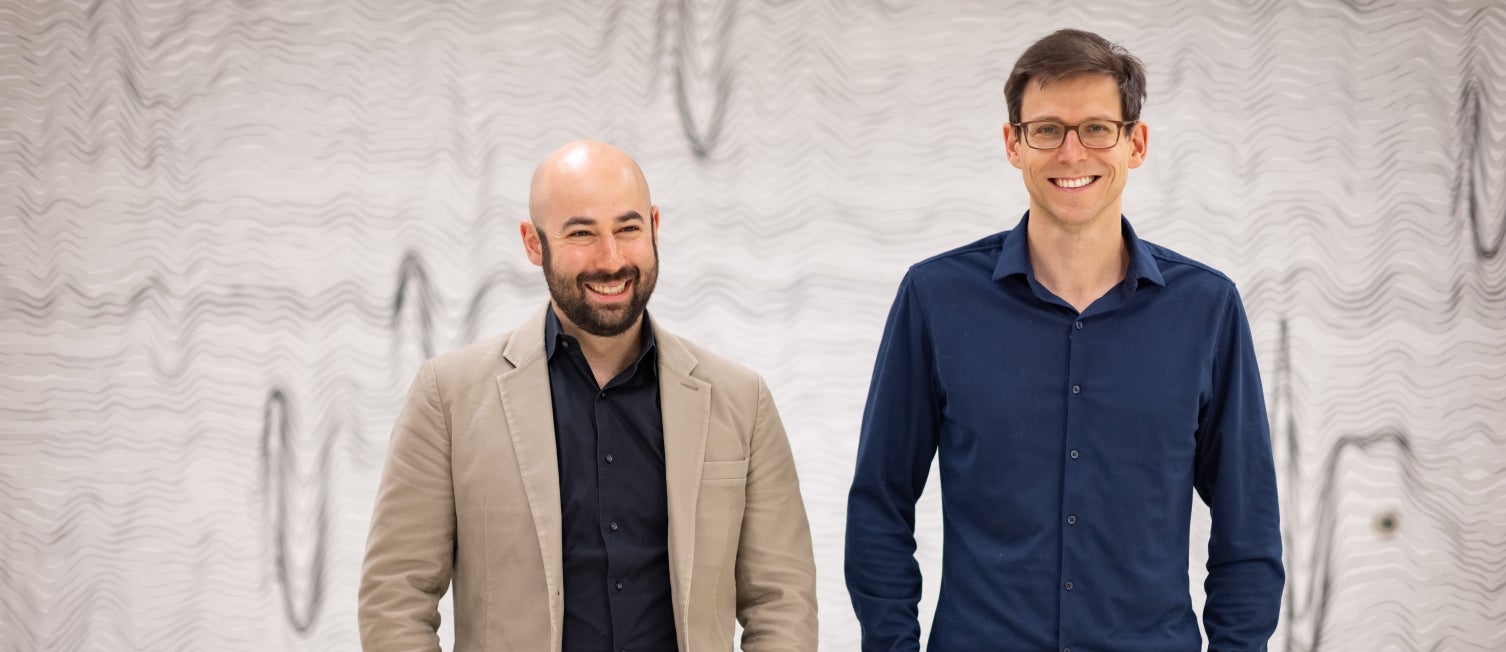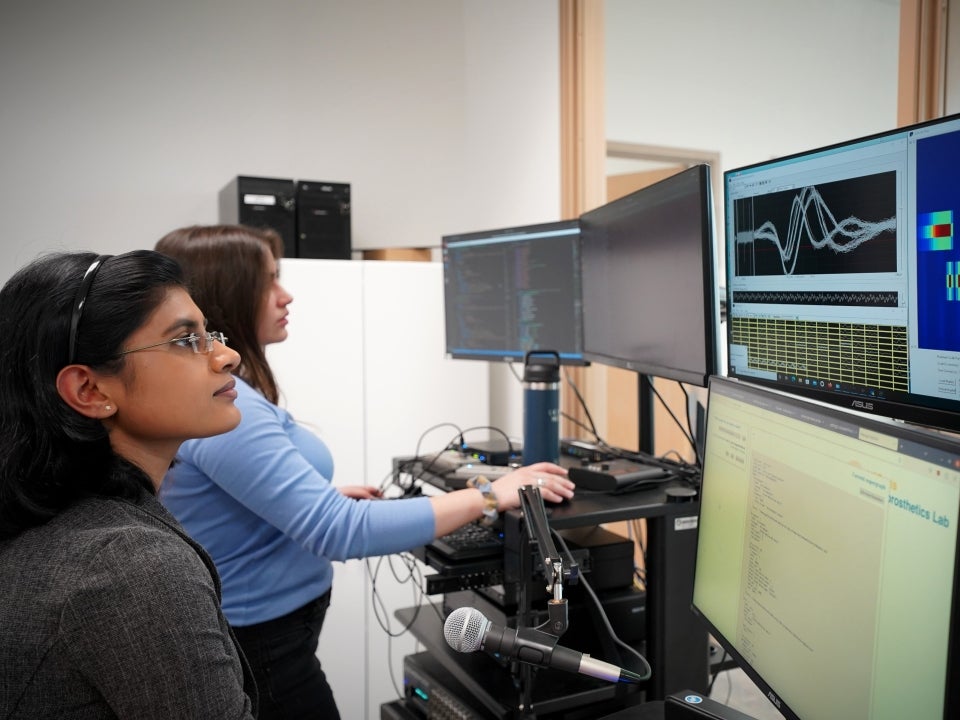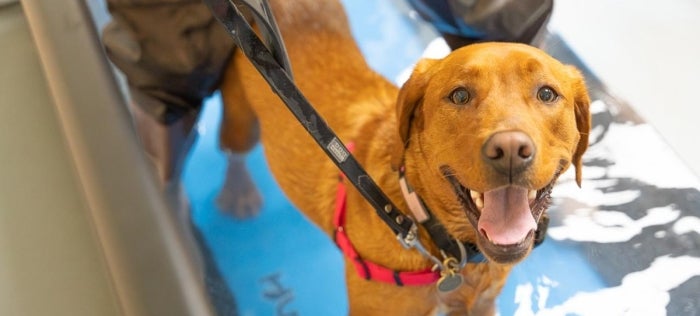
Giving their voice back
Donation advances tech allowing those with paralysis to communicate
Imagine someone with paralysis having their first conversation with a loved one in years. Or imagine them making a simple request—I need my glasses—and the words appearing as text on a screen while spoken out loud by a computer.
This life-changing technology is quickly becoming a reality at the UC Davis Neuroprosthetics Lab thanks to a transformative gift that has accelerated research there. The lab is led by David Brandman and Sergey Stavisky, assistant professors in the Department of Neurological Surgery at UC Davis Health.
“Losing the ability to speak is devastating,” said Brandman, who is a board-certified neurosurgeon. “The number-one need for people living with paralysis is communication, but the existing technologies that can be prescribed by doctors are often inadequate to meet this need.”
Brandman and Stavisky, a neuroengineer, are conducting a clinical trial to build brain–computer interfaces (BCI), electronic medical devices placed in the brain, that can restore speech for people who have lost their ability to speak due to neurological injury or diseases like stroke, Parkinson’s and amyotrophic lateral sclerosis (ALS).
The device is still in the investigational stage, meaning that it can’t yet be prescribed to someone, but their vision is to bring it to patients one day.
“It’s my hope that brain–computer interface technology will one day restore functional independence for people living with paralysis,” said Brandman.
“The information that we learn from these early clinical trials will be essential to bringing this technology to people within the next decade.”
As the lab was starting up in 2021, it received $600,000 from the family of a patient who had received care at the Department of Neurological Surgery.
“This donation allowed us to hit the ground running,” said Brandman. “One of the biggest challenges of starting laboratories is the expense of the equipment, personnel, and actually doing clinical research.”
In less than two years, Brandman and Stavisky have been able to hire a team of students, postdoctoral scholars and staff. In July 2023 they reached the lab’s first major milestone: successfully performing the first brain implant surgery of a clinical trial participant, a man living with ALS and unable to speak.
“We are incredibly grateful to the donors for the opportunity to show that we have a vision for what we want, and that we are trying to address a specific need for people living with paralysis,” said Brandman.
Additional funding can support the cost of the implantation and research for more clinical trial participants and help advance their work to restore other abilities like reach and grasp.

How it works: clinical trial stage
Participants in the clinical trial have tiny devices known as Utah arrays implanted in the region of their brain that coordinates speech. The arrays obtain neural recordings from nerve cells that are conveyed to two small metal pedestals on top of the head.
During data recording sessions, a participant is presented with a sentence on a screen and attempts to say the sentence. As they do, the arrays record brain signals corresponding to attempted movements of the lips, jaw, tongue and voice box.
“By implanting electrodes that can record from individual brain cells involved in generating speech, we hope we can enable the participants to communicate by just trying to speak,” said Stavisky.
To turn the signals into the intended speech, the team uses advanced machine-learning techniques to create computer algorithms that decode the neural patterns into speech. The computer-decoded speech can then be paired with text-generating or synthetic speech-generating devices and displayed or played aloud on the computer.

They hope to recreate a person’s voice in the synthesized speech, gathered from old home videos or past recordings, allowing the patient and their loved ones to hear their voice again.
“This BCI for voice synthesis could allow individuals to speak naturally using their own voice, restoring full range of expressive and prosodic speech, including intonations, at a natural pace,” said Maitreyee Wairagkar, a postdoctoral scholar whose research focuses on synthesizing speech directly from recorded brain signals.
Making the synthesized speech as accurate as possible is essential. Past studies of this type of technology by other research groups captured about 75% of words accurately. The goal is to bring the error rate down to 3% to 5%, where patients could use it for reliable and fast day-to-day communication.
The research is so novel they are still determining what to measure to define success.
“There's no gold standard measure for how well it works yet,” said Stavisky. “We're part of this very small but growing field that is creating new medical devices and we need to quantify and develop new metrics.”
Their study is part of BrainGate, a consortium of universities and academic medical centers studying how brain–computer interfaces can be used to restore neurological function in people living with paralysis.
The right team
A scientist and surgeon co-leading a lab is a rare but innovative setup that allows the research process to come together more efficiently.
“Our lab is a testament to UC Davis’ progressive vision for next generation technology development,” said Brandman. “You need people who are invested in both technology and patient care to bring innovation to patients as quickly as possible.”
Students and staff at the lab come from different areas of expertise, from bioengineering, computer science, neuroscience, surgery and more.
“We focus on translational problems,” said Brandman. “The nature of the work we do is highly multidisciplinary, giving us a tremendous opportunity for further growth.”
For Wairagkar, who was one of the first members to join the lab after its founding, helping build a new lab and research from the ground up has been a special experience.
“Working closely with such highly driven and dedicated researchers, all working towards a common goal of building effective speech BCIs, is exhilarating,” she said. “It’s amazing that we are able to work together to apply our research that can have a direct impact on the lives of our clinical trial participants.”
Having the right team and necessary resources is crucial for conducting clinical trials with people.
“We owe it to people undergoing brain surgery and committing their time to research sessions to do the best possible work at full speed ahead,” said Stavisky. “We need to have a large team that is devoted to working with them and can make the most of their contribution to science.”
Both Stavisky and Brandman noted their gratitude for those who volunteer to participate in clinical trials.
“It takes a very selfless kind of person to be willing to give their time and energy to research that will help people in the future,” said Brandman.
‘Clear pathway’ to building new technology
As they progress in the clinical trial, Brandman and Stavisky are aiming for a faster and more accurate speech BCI. One day, they’d like to see a wireless device that enables instantaneous communication for people with paralysis.
“We want this to be a reliable and robust way for people to communicate, and as intuitive for users as fluent speech is for able-bodied people,” said Brandman.
Their vision for the future includes collaborating with other scientists at UC Davis and in industry to develop the BCI technology further. Their work also provides an opportunity to learn more about the brain and research that can help a wider range of neurological conditions.
“We have a very clear pathway to developing this technology and making UC Davis a world leader in this field,” said Brandman. “We are really well positioned to not only bring this technology forward, but to help grow and expand this vision here at UC Davis.”


